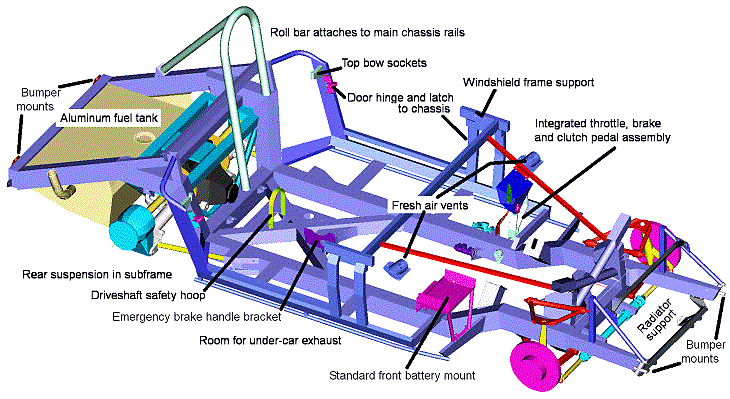The E.R.A. 427 Chassis
| |
| A
tubular steel
sub-structure is
welded directly to the
main rails and
extends completely around
the passenger compartment. This structure provides not only the
mounting
areas for the body support panels, door hinges, latches and dashboard,
but
also some passenger protection.
Some companies use round tubes for the main chassis rails. As you can see above, we use rectangular (4" x 3" x 1/8" wall) steel. |
Loads are fed uniformly through the
chassis rails: There
are no notches or variations in rail size between the major front and
rear
loads into the chassis from the suspension and engine. This
means that
the rails act in the most efficient manner, and there are no
high-stress
areas to initiate a structural failure.
Our powder-coating option will make the chassis rust free and attractive for many years too. |
For
the rest of our design logic, check out our
detailed engineering
comparison
between possible round tube, space frame and monocoque Cobra
chassis.
Because the inner panels of body rivet and bond to the chassis, we have created a semi-unitized structure that extends from the front of the engine compartment through the rocker panels and along the rear of the passenger compartment. Assembling the car with this degree of integration may take a little longer, but you end up with a much stiffer overall structure. Our bare chassis has been measured at approximately 3200 lbft/deg. The body and inner panels will add at least an additional 300 lbft/deg. Not bad for an open car!
Our suspension pickup points feed loads directly into the chassis, minimizing bending moments. Where there are practical limitations, large sections and/or reinforcements are designed in. The chassis allows the suspension to take full advantage of today's advanced tire technology.
Our optional roll bar is actually functional, bolting directly to the main chassis rails. Kind of nice, considering some other replicas' bars are there just for show! While we're on the safety stuff, note that all the seat belt and shoulder harness mounting points (with threaded inserts) are designed into the chassis.
And a little Crash Protection: Our chassis has two stages of impact dissipation.
- The bumpers will collapse progressively until the bracket contacts the front of bumperette.
- The kickups in the front section of the chassis are designed to distort progressively up and back under severe impact.
Frankly, the doors, while steel lined, don't offer great side impact protection. The original latches are just not strong enough for a heavy intrusion. Our construction is mostly designed to keep the doors from sagging. We've added some reinforcing within the sill that will deflect most modern sedan's bumpers. Unfortunately, SUV's will be above our protection.
It has been said that these cars should be driven as if they were a motorcycle, and there's some truth in that.
427/chassis.htm 10/8/06
